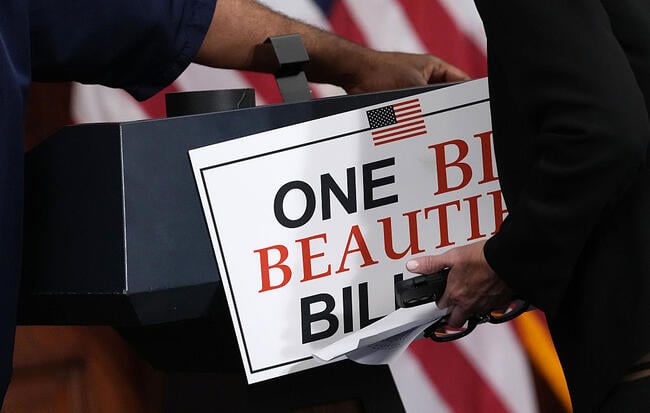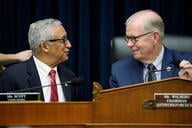You have /5 articles left.
Sign up for a free account or log in.

The House version of the One Big Beautiful Bill Act would cut about $1.3 trillion in spending over the next 10 years.
Kevin Dietsch/Getty Images
The clock is ticking for Senate Republicans as they rush to approve a sweeping bill that cuts spending and taxes and pays for some of President Donald Trump’s top agenda items by the Fourth of July.
If passed, the complex piece of legislation—known as the One Big Beautiful Bill Act—could entirely reshape the student loan system, increase endowment taxes, force colleges to repay their students’ unpaid loans and significantly cut Medicaid, among other changes.
The House passed the measure late last month, putting the ball in the Senate’s proverbial court. But key senators have since said little about the higher ed provisions in the bill, so it’s unclear what lawmakers in the upper chamber will prioritize. Higher ed experts predict risk-sharing, or the plan to require colleges to pay a penalty for unpaid loans, likely won’t survive. Other issues, like whether to change the eligibility criteria for the Pell Grant, are more uncertain. But any changes to the House bill will come at a cost, as saving one program likely will mean deeper cuts to another.
Over all, lawmakers will face a difficult balancing act to get the legislation through the Senate without endangering a second passage in the House, where bill advanced by the skin of its teeth. And Trump has called the bill the single most important piece of legislation in his second term, suggesting that failure is not an option.
“The One, Big, Beautiful Bill will implement President Trump’s Make America Great Again agenda by delivering the largest tax cut in American history, the largest border security investment in history, and the largest deficit reduction in nearly 30 years," Press Secretary Karoline Leavitt said in a statement last month. “The Senate should pass this critical legislation as soon as possible to usher in America’s Golden Age.”
The Congressional Budget Office has estimated the bill would add $2.4 trillion to the deficit over a decade.
What’s Next
The Senate Health, Education, Labor and Pensions Committee hasn’t yet released its version of a reconciliation bill, though a draft is expected soon since congressional leaders are hoping to get a vote on the legislation by June 16, sources familiar with the Hill say. Lawmakers are using the reconciliation process, so they only need 51 votes in the Senate to pass the bill. But if the Senate version is at all different from the House’s, the House will have to vote again before the legislation can reach the president’s desk.
When a bill does drop, it will likely skip the traditional committee markup, so the legislation can reach the Senate floor for a vote faster. But that fast tracking will limit the time for college leaders and others to review and weigh in on the bill.
Policy analysts say Senate and House Republicans will likely have to make some compromises in order to move the bill forward. Some Senate Republicans may stand firm and advocate for changes on certain provisions, but the question is which ones will earn priority and which ones will fall by the wayside. For instance, can moderate Republicans save both the Pell Grant and Medicare? Or will they have to choose between the two?
In many cases, what spending cuts and program changes survive is going to depend on “how the tug-of-war between the House and Senate plays out,” said Preston Cooper, a senior fellow at the American Enterprise Institute, a right-leaning think tank.
All of this, however, could be thrown for a loop if former Trump adviser Elon Musk holds any influence. The billionaire tech mogul who previously led Trump’s Department of Government Efficiency has launched an all-out feud with the president over social media, calling the bill a “disgusting abomination” and saying, “shame on those who voted for it.”
At Odds Over Accountability
If the reconciliation bill does move forward, policy experts expect the Senate to propose a very different version than the House. And Michelle Dimino, director of education at Third Way, a left-leaning think tank, said she’s looking to the Lowering Education Costs and Debt Act, a bill introduced by Louisiana senator Bill Cassidy in 2023, for an outline of what it may include. (Cassidy is the chair of the Senate education committee.)
“Senate and House Republicans have not always been aligned in their approach to higher ed reform,” she said. And “unsurprisingly, each chamber tends to favor legislation that originated internally.”
One of the most notable differences Dimino and others anticipate between the House and Senate is how each tries to hold colleges accountable for students’ financial outcomes.
House Republicans want to use risk-sharing, a strategy that would require colleges and universities to pay a fee each year based on the amount of loans their graduates (or those who left without a degree) have failed to repay. But the formula for calculating that fee is complicated, and colleges have a lot of questions about how it works and whether it’s fair. The Congressional Budget Office estimated that these risk-sharing payments would total $1.3 billion by 2034 and then continue to increase annually.
Meanwhile, the Lowering Education Costs Act calls for a plan similar to the gainful-employment rule—a metric that ties colleges’ financial aid eligibility to their students’ earnings and debt levels. The idea was first introduced by President Obama, scrapped by President Trump in his first term and then expanded by President Biden.
Under gainful employment, colleges would have to show their graduates make more than someone with a high school diploma and that their loan payments will be affordable. If a college ever falls below those thresholds, it could lose access to all federal student aid. The Senate plan would likely apply to all colleges, whereas the current gainful-employment rule only applies to for-profit colleges and nondegree programs.
Higher education lobbyists are generally more supportive of the Senate’s anticipated proposal. But they note that while it’s a much lesser evil than risk-sharing, concerns remain, especially about how it would affect institutions.
“When the data is not available … we are operating off concepts and ideas,” said Emmanual Guillory, senior director of government relations at the American Council on Education. “So it begs the question: What is the intended outcome and is this proposal the solution?”
Other Key Issues to Watch
What is less certain, policy experts noted, is whether the Senate will sign off on the House’s plans to consolidate student loan repayment plans, cap loans, increase endowment taxes and change who is eligible for the Pell Grant. For example, while the House proposed waiving borrowers’ interest if their monthly income-based payment isn’t enough to cover what’s owed and forgiving remaining debt after 30 years of payments, Cassidy’s legislation would create a more traditional plan where students accrue interest but all is forgiven after 20 or 25 years of payments.
And though the House plan would eliminate subsidized loans, end the Grad PLUS loan program and limit Parent PLUS, experts predict that the Senate will likely end both Grad and Parent PLUS and put more aggressive limits on how much students can borrow over all.
But other aspects like Pell Grant eligibility were not discussed in Cassidy’s 2023 bill at all. So while the House would expand the Pell Grant to short-term workforce programs and limit access for the full-time Pell program, it’s unclear what, if anything, the Senate would propose. At a recent hearing, some senators appeared reticent to make deep cuts to the Pell program, though lawmakers have generally supported the concept of workforce Pell.
Over all, it’s hard to know exactly where the Senate will fall on most issues, Guillory said, especially because unlike during most sessions, it seems the House has the upper hand.
“I think the Senate would like to propose a very different bill that would require a lot of back-and-forth compromise, but they are feeling more and more pressure from the House to make fewer changes in order to get the bill passed quicker and to meet that July 4 deadline,” he said.




